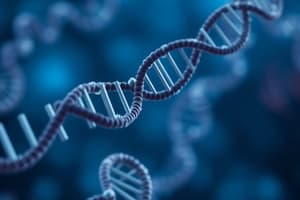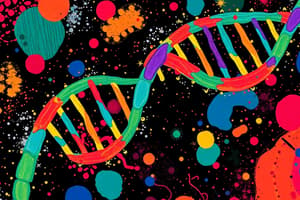Podcast
Questions and Answers
What is the purpose of adding the 5' guanosine triphosphate cap to pre-mRNA?
What is the purpose of adding the 5' guanosine triphosphate cap to pre-mRNA?
- It signals the start of transcription.
- It enhances the nucleotide sequence of mRNA.
- It facilitates the removal of introns.
- It aids in transporting mRNA across the nuclear membrane. (correct)
Which component is responsible for removing introns from the pre-mRNA molecule?
Which component is responsible for removing introns from the pre-mRNA molecule?
- Transcription factors
- Ribosomes
- Spliceosome (correct)
- Polyadenylation factors
How many adenine nucleotides are typically added to the 3' end of pre-mRNA during polyadenylation?
How many adenine nucleotides are typically added to the 3' end of pre-mRNA during polyadenylation?
- 100-150
- 200-250 (correct)
- 50-100
- 300-350
What is the role of exons in pre-mRNA?
What is the role of exons in pre-mRNA?
What overall effect do both the 5' cap and poly A tail have on mRNA?
What overall effect do both the 5' cap and poly A tail have on mRNA?
Flashcards
Pre-mRNA
Pre-mRNA
The initial RNA transcript produced directly from DNA transcription. It needs modifications before leaving the nucleus.
5' cap
5' cap
A modified guanine nucleotide added to the 5' end of pre-mRNA. It protects mRNA from degradation and helps it exit the nucleus.
Poly A tail
Poly A tail
A long chain of adenine nucleotides added to the 3' end of pre-mRNA. It helps stabilize mRNA and ensure its proper transport.
Exons
Exons
Signup and view all the flashcards
Introns
Introns
Signup and view all the flashcards
Study Notes
Transcription and RNA Processing
- Transcription produces RNA molecules from DNA, transferring genetic information.
- Messenger RNA (mRNA) serves as the template for protein synthesis.
- Pre-mRNA is the initial RNA transcript produced directly from transcription, requiring modifications before exiting the nucleus.
Post-Transcriptional Modifications
-
5' guanosine triphosphate cap:
- Added to the 5' end of pre-mRNA via a 5'-to-5' triphosphate linkage, forming a 7-methylguanosine cap.
- Protects mRNA from degradation during translation and aids in exiting the nucleus.
- Function: Increases stability and aids in transport across nuclear membrane.
-
Polyadenylation (Poly A tail):
- A series of adenine nucleotides (200-250) are added to the 3' end of pre-mRNA after a small section is removed.
- Function: Increases stability and aids in transport out of the nucleus.
-
Splicing:
- Exons: Regions of pre-mRNA that code for protein.
- Introns: Non-coding regions of pre-mRNA.
- Spliceosome: A complex of proteins and RNA that removes introns and splices exons together.
- Function: Produces the final mRNA molecule, ready for protein synthesis.
Importance of Modifications
- The 5' cap and poly A tail protect mRNA from degradation and increase its stability in the cytoplasm.
- These modifications also facilitate the movement of mRNA from the nucleus to the cytoplasm for protein synthesis.
Studying That Suits You
Use AI to generate personalized quizzes and flashcards to suit your learning preferences.




